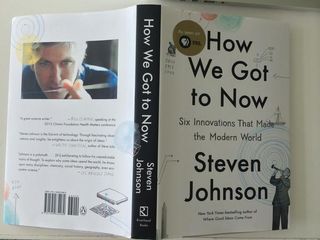How We Got To Now, the Book
Last Tuesday was the publication date for How We Got To Now: Six Innovations That Made The Modern World. It’s my ninth book, but the first to be accompanied by a TV series, airing on PBS beginning on October 15. It’s also by a wide margin the most appealing physical book I’ve ever published: Geoff Kloske and the team at Riverhead did an amazing job with it--great design, full-color images throughout, nice paper stock. (It will make an excellent Christmas present, if you’re into that kind of thing.) I wrote up a few thoughts about the relationship between the book and show at our new site, How We Get To Next. 
It has been a busy week! I thought I would try to round up all the initial reactions and appearances before the rollout of the TV series begins in earnest. But to start, I should mention two appearances coming up this week: on Wednesday, Oct. 8, I will be giving a talk and signing at the legendary Powell’s in Portland at 7:30 PM. (CSPAN BookTV will apparently be filming if you’d like to ask a question in front of a national TV audience.) The next night, Oct. 9, KQED is sponsoring a special screening and conversation with my friend Biz Stone (of Twitter fame) at the Castro Theater in SF. (It’s free but you need to get tickets in advance here.)
So far the reception to the book has been very enthusiastic. I did the Daily Show with Jon Stewart last Thursday, which is always a blast. We talked time zones, random pigs, and why New Jersey residents are pioneers in drinking poisoned water. The Guardian’s review said that the book was “readable, entertaining, and a challenge to any jaded sensibility that has become inured to the everyday miracles all around us.” In the Wall Street Journal, Philip Delves Broughout put together a great overview of some of the journeys the chapters take the reader on:
In "Cold," we move from air conditioning, to the flocking of American retirees to the now habitable Sunbelt, to the shift of political power from north to south. Freezing leads him to the creation of sperm banks, which have given many more women the opportunity to conceive and changed our notions of marriage and parenthood. "Sound" begins in the reverberating cave dwellings of Paleolithic man in Burgundy and ends up with the ultrasound technology being used to determine the sexof unborn children. "Clean" takes us from Chicago's sewer system, the first urban system in America, to the growth of household cleaning products like Clorox and the hypersanitized plants where microchips are made.
The Daily Beast called it a “mind-expanding read.” In the Washington Post, Fred Vogelstein wrote, “Johnson is an engaging writer, and he takes very complicated and disparate subjects and makes their evolution understandable,” while noting -- accurately, I think -- that some sections could have been treated in more depth. Back in the UK, in the Sunday Times, the wonderful science writer Matt Ridley began his review with this:
The meteorologist Edward Lorenz famously asked, in the title of a lecture in 1972: “does the flap of a butterfly’s wings in Brazil set off a tornado in Texas?”, and the phrase “the butterfly effect” entered the language. If Steven Johnson’s book How We Got to Now catches on — and it deserves to — then the “hummingbird effect” will also become common parlance.
Speaking of the “hummingbird effect” -- my term for the unlikely consequences of new innovations -- I am running a collection of short essays on this topic at Medium over the next few weeks.
There’s more, but I think those are the headlines. It’s off to a great start, which is nice to see, given that I have been working on this project for almost four years now. I hope you get a chance to pick up the book over the next few weeks.







